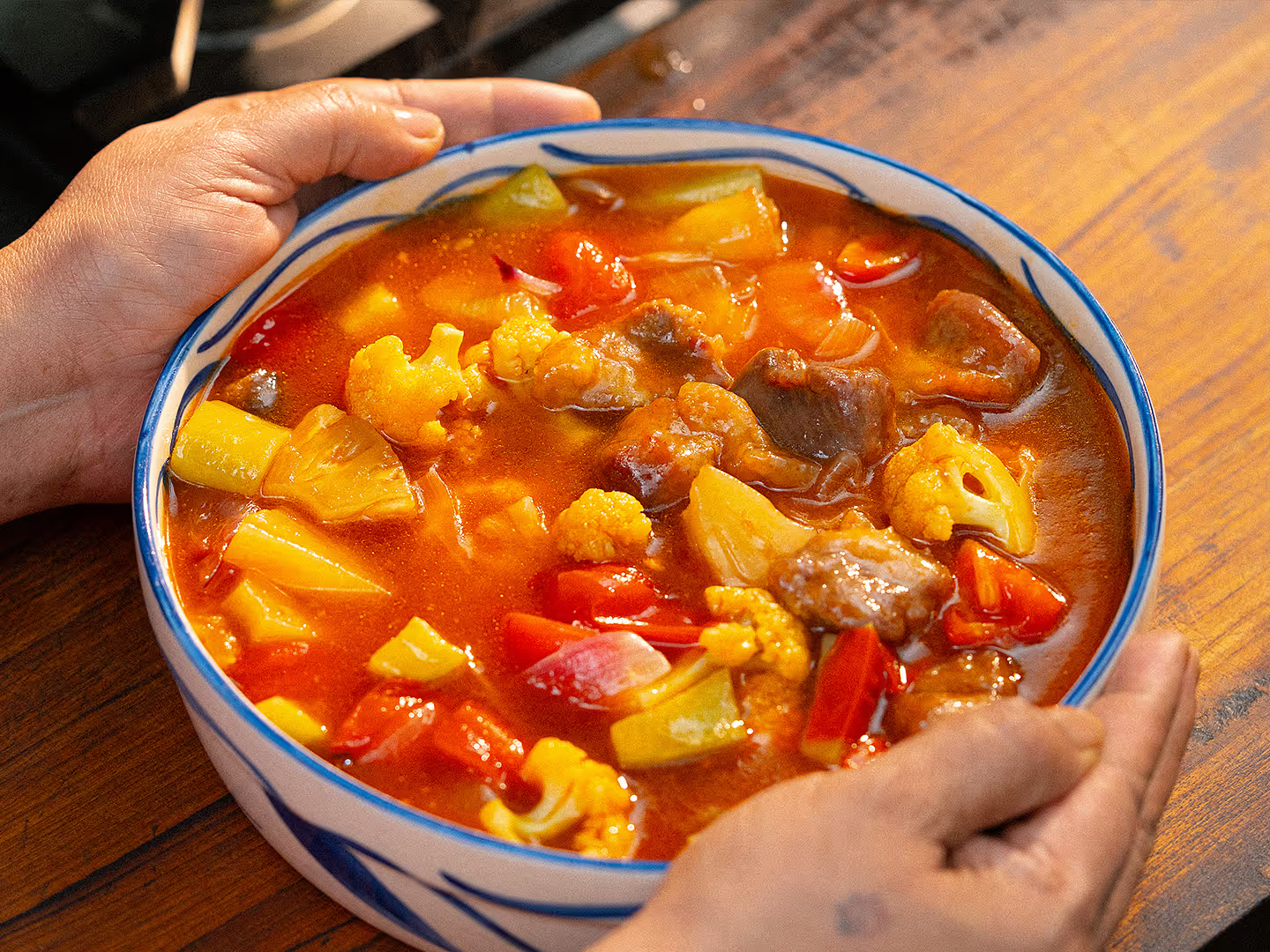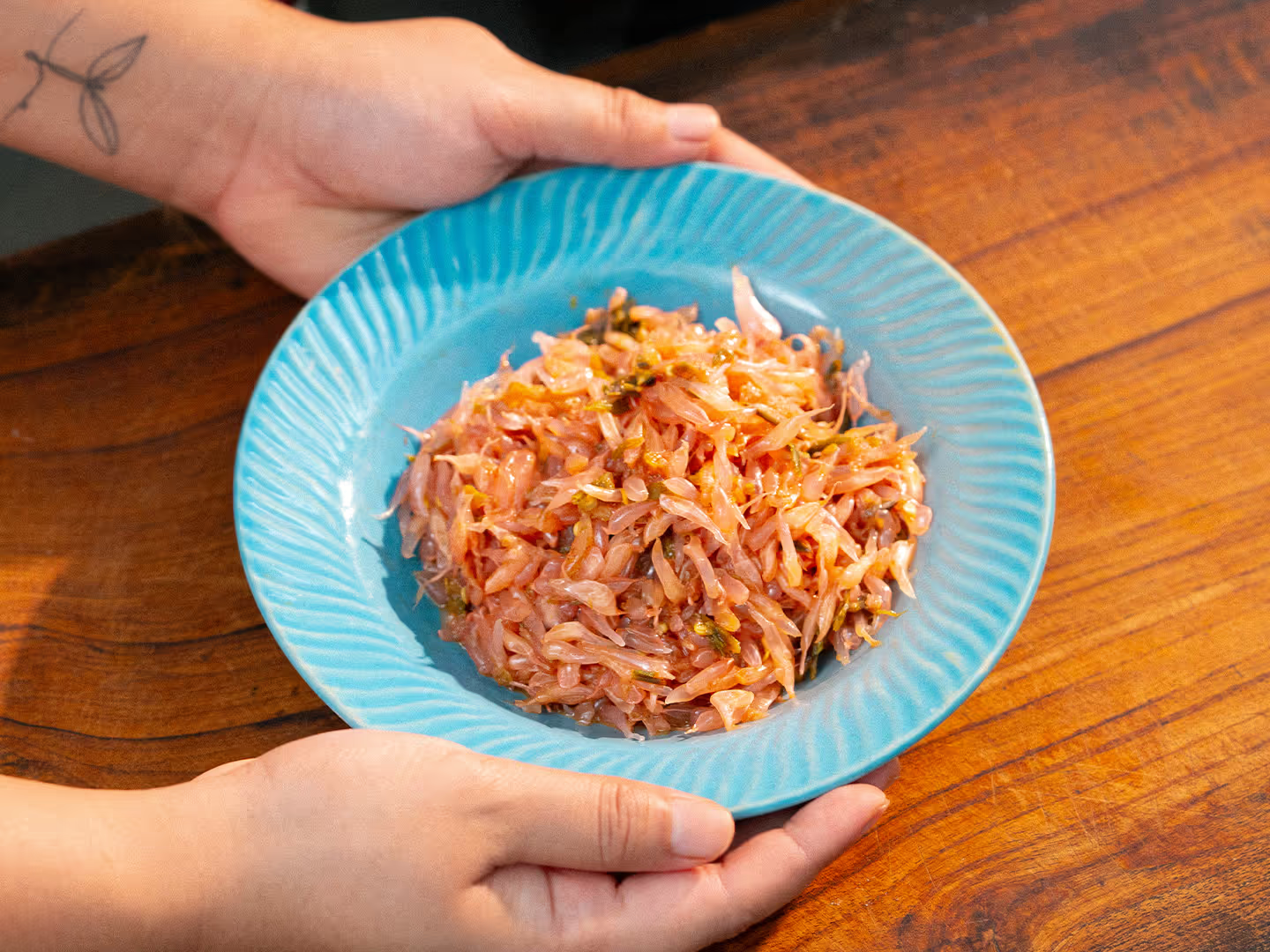Chelo Kabab
A platter of chicken and lamb kababs, served with buttered saffron rice, roasted tomatoes and an egg.
- Cooking time4 hours
- Calorieskcal
Chelo kabab, to any Calcuttan, is a dish served at Peter Cat—the '70s restaurant on Park Street that doesn’t accept reservations, and always has a crowd of people waiting outside for a table. But who would have thought that this “PROTECTED REGIONAL PRODUCT OF WEST BENGAL” happens to be an Iranian dish comprising chelo (fragrant rice) and kabab (barbecued meats)?!
In this recipe, we make two types of kababs—jujeh or chicken kabab, and koobideh or minced lamb kabab—served with buttered saffron rice (chelo), roasted tomatoes, onions, capsicum, a fried egg, and last but not the least the crunchy delicious rice crust, tehdig/tah-dig.
For this recipe, we had originally wanted to recreate the famous Peter Cat chelo kabab. But when researching this recipe, we fell down the amazing rabbit hole that is the world of Persian cuisine—so we figured, why not make chelo kabab, Iran’s “national dish”, the way it would be made in Iran. The main source for these recipes is Najmeih Batmanglij tome on Iranian cooking, Food of Life: Ancient Persian and Modern Iranian Cooking and Ceremonies. The spices used are more subtle than what we associate with kababs in Mughlai cuisine.
This recipe is quite involved, and while there is some satisfaction in achieving this at home, you can still try the chelo kabab from Peter Cat, or from our current favourite go-to for chelo kababs, Trincas.
Frequently Asked Questions
Books in this recipe
Ingredients
For the jujeh (chicken kabab)
- 500 g chicken thigh (boneless)
- 2 tbsp rose water
- 1 tbsp saffron water
- 120 g onion
- 5 g salt
- 20 g onion juice
- ½ tsp pepper
- 40 g yoghurt
- ½ tsp lemon zest
- ½ tsp turmeric
- 15 g lemon juice
- 30 g olive oil
For the koobideh (minced meat kabab)
- 500 g minced mutton/lamb
- 7 g salt
- 10 g sumac
- 1 tsp pepper
- 70 g squeezed onion
- 3 g garlic paste
- 1 tsp lime zest
- ¼ tsp baking soda
- ¼ tsp saffron water
For the chelo (rice)
- 200 g basmati rice (long-grained)
- 15 g salt (+2 tsp extra for soaking the rice with)
- 1 L water
For the tah-dig (golden crust)
- 30 g yoghurt
- 1 egg yolk
- 1 tsp saffron water
- 40 g butter (melted)
- 3 spoons cooked rice
For dum cooking
- 20 g melted butter
- ¼ tsp saffron water
- 30 g water
For skewering/grilling
- tomatoes
- onions
- capsicum
Method
Jujeh (chicken kabab)
- Divide the chicken thigh into 6-cm chunks.
- Grind about ½ tsp saffron strands with a few grains of sugar or micchri (rock candy). Once it is powdered, add 2 tbsp warm rose water to it. Mix well. This is saffron water, and we will be using it through this recipe to flavour the various components.
- Grate onions. Transfer it to a strainer. Then, start squeezing the grated onions to collect onion juice in a bowl. We need 20 g onion juice. Once the juice is extracted, save the squeezed onion for lamb kababs.
- Zest a lemon/lime, and then juice it.
- In a mixing bowl, marinate the chicken with salt, 1 tbsp of saffron water, onion juice, freshly ground pepper, yoghurt, lemon zest, turmeric, lemon juice, and olive oil. Mix everything well, as set aside.
Koobideh (minced meat kabab)
- In another mixing bowl, take the minced meat (lamb/mutton), along with salt, sumac, pepper, squeezed onion (from the previous stage), garlic paste, lime zest, baking soda, and ¼ tsp saffron water.
- Start kneading the mixture. Add 1 tablespoon of water and continue kneading for 5 minutes, at the end of which the mixture should become tacky and stick to the sides of the bowl. This is important, as it will help the kababs to bind and stay on the skewer, instead of falling off in the oven.
Dhungar
- To infuse burnt-charcoal flavour to both the kababs, first, set a small metal bowl (or a DIY bowl fashioned from aluminium foil) at the centre of each mixing bowl containing the marinating kababs.
- Burn a piece of charcoal directly over the flame until you see a layer of ash on the outside (this will take about 5–7 minutes). Place it in the metal bowls and pour ghee on it.
- You will immediately see smoke rising from the charcoal. Cover tightly to hold the smoke in. Smoke both the kababs for 10 minutes. Remove the charcoal once done. Give both the kababs a mix, cover and continue marinating them in the refrigerator for 8 hours.
Chelo (rice)
- Wash the basmati rice very well by rubbing it between your palms. Change the water 2–3 times until it runs clear. When the rice is washed properly, you will be able to smell the perfume of the rice.
- Soak it with about 2 teaspoon of salt for 2 to 24 hours. A long soak with salt will firm up the rice, lengthen the grains, and keep them fluffy and separate when cooked.
- In a boiling pot, add a litre of hot water and 15 g salt. When it comes to a rolling boil, add the soaked and drained rice.
- Cook for 6–10 minutes, until the grains are firm but cooked, that is, the centre is not hard.
- Drain the rice over a strainer. Rinse with cold water to remove the excess starch that makes rice sticky. Shake off excess water.
- For the tah-dig, in a mixing bowl, add yoghurt, egg yolk, saffron water, melted butter, and some of the cooked rice, in the proportions given. You should take enough cooked rice to cover the base of your pot. Gently fold everything in. Be careful not to break the rice.
- Transfer this mixture to a non-stick pot with a lid, or a well-seasoned dutch oven with a lid. These will ensure that the crust comes out intact.
- Spread the rice mixture over the base of the pot.
- Add remaining rice in a heap; do not flatten. According to Najmieh, the pyramid shape leaves room for the rice to expand further. Cover and cook on medium heat for 10 minutes. This direct contact with medium heat will have formed the crunchy tah-dig.
- The next part of the cooking needs to take place over indirect heat. For this, heat up a heavy skillet or tawa. Place the pot/dutch oven over it. Uncover and add melted butter, saffron water, and water, in the given proportions. Make three holes using the back of a spoon to let steam escape.
- Tie the lid of the pot in a towel to create a tight seal. This will also absorb any condensation, keeping the tah-dig formed already from turning soggy.
- Cook on dum on low heat for 1 hour. If rice has not swollen enough, cook for 15–20 more minutes with 2 tbsp of water.
- Remove from the heat and place the pot on a wet towel to help free the crust from the pan.
Skewering and grilling
- Skewer some whole tomatoes and lay them on a grilling tray.
- For the jujeh (chicken kabab), cut onion and capsicum in 5-cm squares. Separate the layers of the onion. Add these to the marinated chicken, along with wholes cloves of garlic. Mix everything well.
- Now, fold chicken pieces in half. Skewer the chicken, alternating it with capsicum or onion or garlic. Lay the skewers on the grilling tray alongside the skewered tomatoes.
- For the koobideh (minced meat kabab), take the marinating mince out of the refrigerator. Wrap about 200 g of the mince (the quantity will depend your the length of your skewers) around the top of the skewer.
- Using wet hands, start distributing the mince, so that you have a flat, long section of the mince around your skewers. Try and maintain an even thickness throughout.
- Koobideh typically have a ribbed surface, so create ridges using your thumb and index finger.
- Preheat your oven to 250°C, or the highest temperature it will go.
- Roast all three types of skewers (tomato, chicken and lamb mince) in a preheated oven at 250°C for 20 minutes.
- Serve the rice with tah-dig, kababs, roasted tomatoes, cucumber, and a crunchy fried egg.































